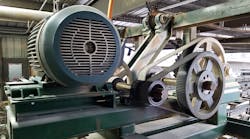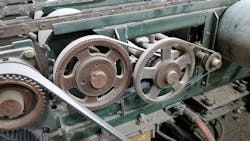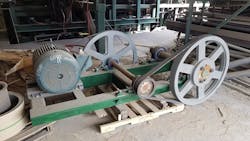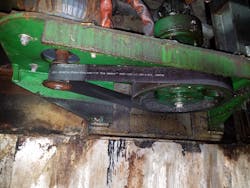Plant managers are continuously looking for new ways to cut costs, improve safety, and increase efficiencies, and often those benefits can be found by converting their power transmission systems. Depending on the industry and application, different power transmission products have historically been used including gearboxes and belt drives. Now more than ever, the synchronous belt is emerging as the best choice across many industries because of its extreme cost-effectiveness. While the initial appeal may be that belt drives can cost two-thirds less than large gearboxes, there is additional value in the elimination of oil leaks, extremely improved cost and reduction of maintenance requirements, and improved working capital.
Gearbox Drawbacks
Gearboxes for power transmission processes in industrial applications often involve higher costs, seal leaks, and oil maintenance. Manufacturing operations that rely on a gearbox also run into trouble when it must be replaced. Replacement costs can be anywhere from $3,000 to $50,000-plus and can have long lead times to replace, significantly reducing the opportunity to meet operational goals due to downtime. Typically, plant managers purchase multiple spare gearboxes to mitigate wait times when they experience a breakdown. It’s a big investment, particularly for plants that rely on multiple gearboxes throughout their facility to keep the business running.
Maintenance managers must also constantly monitor seal leaks, a very common occurrence with gearboxes. As operations powered by gearboxes often utilize several conveyors throughout the plant, oil drip pans are commonly placed throughout the facility to catch leaks. This can create safety issues such as fire and slipping hazards for employees. Oil leaks can be even more dangerous in a saw mill environment. In a scenario where oil and sawdust are abundantly present, the two materials can mix and result in an unexpected fire.
Oil maintenance for gearboxes is also an ongoing occurrence that creates a dirty environment and requires valuable employee time.
7.5 HP double reduction 17.6:1 the first reduction (far right) is a 20-mm-wide Gates PowerGrip GT 3 rubber belt and second reduction (center) is a 21-mm-wide Gates Poly Chain GT Carbon. In the foreground (left) is a #80 roller chain replacement.
The Benefits of Belts
Plant managers who have converted from gearboxes to belts realize the many benefits, such as upfront cost savings, lighter parts, minimal maintenance requirements, longer life, and increased safety.
These polyurethane belts, unique to Gates, are made with carbon fiber tensile cord and an anti-friction nylon tooth surface. The advanced materials used in this belt construction mean they require zero maintenance aside from simply greasing the bearings, and offer years of service. Other manufacturers make synchronous belts, but most are rated at 50% or less than Poly Chain, making them wider and more costly, in addition to taking up more space.
60 HP double reduction17:1. Drive platform staged for install.
Are You a Belt Contender?
Industries with applications that are ideal to switch from gearboxes to belts include sand, gravel, and crushed stone plants; saw mills; steel mills; heavy industry plants; and many others. What follows are some real-world examples of successful gearbox-to-belt conversions:
A rubber molding company in western North Carolina experienced a failed gearbox on its rubber calendar application. This was slated to cost the company $35,000 and would take 16 weeks to implement.
Alternatively, the plant chose a triple reduction 100HP 40:1 belt drive that cost less than $5,000 and was up-and-running in two weeks. The company has been running on belts since 2001, and is delighted with the performance and reliability of these drives.
A steel mill in Charlotte, N.C. that uses a form shaker to make merchant bar was finding that grit and iron pieces were getting into the gearbox seals on all three lines, causing them to break down and thus require replacement three times a year (every four months). Each new gearbox has a $5,000 price tag, plus downtime and labor, for an annual cost of roughly $45,000 to replace in a harsh and hazardous environment.
In 1999, the steel mill converted its three gearboxes to belts, and while the conversion cost, including belts, sprockets, shafts, bearings, etc. was roughly equal to what was originally spent on gearboxes, the conversion allows for an increased ease of use and has dramatically reduced maintenance requirements. Belt sprockets do wear out over time, and the mill has made replacements in the subsequent 19 years; however, the drastic differential in maintenance and downtime costs has paid off. By converting to belts, the organization now has a reliable solution that has allowed the company to save well over $1 million since 1999, and those savings will continue into the future.
A sawmill generating 650,000 board feet a day of lumber products on a 25-acre site found that approximately every 18 months, the $30,000 gearbox on its kicker was breaking the output shaft. If it opted for a bigger gearbox, the cost would be $50,000 and would come with a larger output shaft. Alternatively, the company chose a belt drive system with a 5-in. final shaft. While the original purchase price was similar to the gearbox, that same belt drive system has been operational for six years with no downtime or breakage.
The company previously had 105 gearboxes in service with nearly the equivalent in spares. Since converting many of the gearboxes to double- and triple-belt reduction Poly Chain drive systems, the company has been able to reduce that total amount of gearboxes to 50. Due to the success it is experiencing with the belts including durability, reliability, and zero-maintenance requirements, the company continues to convert all gearboxes to belts before they fail in order to eliminate downtime. The spare gearboxes that were previously held in inventory due to long lead times, are being eliminated, improving working capital.
While the cost savings are impressive, the most valuable benefits of this gearbox-to-belt conversion is increased employee safety, as sawdust and oil no longer mingle and present a fire hazard.
A drive that was converted, 6:1 belt reducer, over 20 years ago at a steel mill; belt replacement every 3-5 years significantly reduces maintenance costs.
Conversion Tips
If you’re looking to change out your gearbox for a belt, it’s important to keep ratio targets in mind. A good rule of thumb is to look at your reduction numbers to determine if belts are your best option. Plants that falls within the ratio targets below are prime for a gearbox-to-belt conversion:
- Single reductions - 1:1 to 8:1
- Double reductions - from 8:1 to 30:1
- Triple reductions - from 30:1 to 50:1
It’s important to keep in mind that even higher ratios can be addressed based on load and space requirements.
Also, when planning to remove gearboxes and go with belts, make sure to align with a partner that can fabricate proper rigid structure, with the ability to tension and align the belt drive system properly. Oftentimes, companies turn to a fabrication shop for this. Consider selecting a partner with the knowledge and experience to fabricate the belt conversion and set it up for full operation, while also accommodating the footprint available. Once the belt conversion is underway, increased savings and decreased safety hazards will soon follow.
Tom Pitstick is CMO and SVP of product line management for Gates Corporation.




